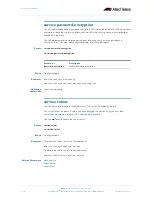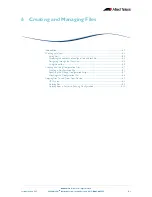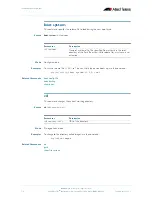
Creating and Managing Files
©2008 Allied Telesis Inc. All rights reserved.
6.8
AlliedWare Plus
TM
Operating System Software Reference C613-50003-00 REV E
Software Version 5.2.1
You can change the content of the file set as the startup-config file by:
■
entering commands directly into the CLI, then saving this configuration using the
command:
awplus#
copy running-config
startup-config
This command saves the device’s dynamic configuration into the file that is currently
configured as the startup-config file.
■
writing commands into a configuration file (see
“Creating a Configuration File”
below),
then using the command:
awplus#
copy SOURCE-URL startup-config
This command saves the script from the source file into the file that is currently configured
as the startup-config file.
To display the name of the configuration file that is set to execute when the device restarts,
enter the command:
awplus#
show boot
To see the commands in the startup-config file, use the command:
awplus#
show startup-config
To erase the file set as the startup-config file, use the command:
awplus#
erase startup-config
At the next restart that occurs after you’ve erased the file, the device loads the configuration in
the file
default.cfg
. This file is set on the system as a backup configuration file that loads if no
other file is set as the startup-config file.
Working with Configuration Files
When you use the CLI or GUI to configure your device, it stores this dynamic configuration as
a list of commands called the
running-config
. To view the device’s running-config, use the
command:
awplus#
show running-config
If you turn off the device or restart it, any unsaved changes to the running-config are lost. To
save the running-config as a configuration script, use the command:
awplus#
copy running-config DESTINATION-URL
You may have many configuration files. Storing them on a device allows you to keep a backup
device with configuration scripts for every device in the network to speed up network recovery
time. Multiple scripts also let you test new configuration scripts before setting them as the
startup-config. For example, to test a new script named test.cfg, enter the command:
awplus#
copy flash:/test.cfg running-config
This allows you to run a configuration file any time without restarting the device, by replacing
the system’s current dynamic configuration with the script in the configuration file. However,
note that some commands require you to restart the device before they can take effect, such
as the
platform
commands.
You can also set a trigger to automatically execute a configuration script when a predetermined
event occurs. For information about creating triggers, see
Chapter 59, Triggers Introduction
.






























